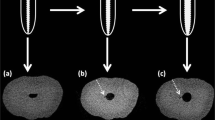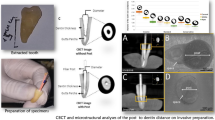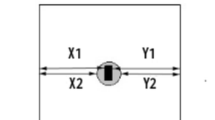Abstract
Objectives
The purpose of this study was to determine in vitro using a synchrotron radiation-based μCT (SRCT) whether rotary and reciprocating nickel titanium (NiTi) instrumentations lead to the formation of dentine microcracks.
Material and methods
Fourteen extracted human molars were obtained with ethical approval. Seven distobuccal roots of the maxillary molars and seven mesial roots of the mandibular molars were assigned to two experimental groups: (A) prepared with rotary Pro Taper instrumentation (n = 6) and (B) reciprocating WaveOne (n = 6). Irrigation with 1 % NaOCl and 17 % EDTA solutions was carried out. The remaining roots served as positive control with induced fractures (group C). SRCT was used to scan all samples pre and post-operatively. An imaging software was used to determine the number and length of microcracks. Statistical analyses weighed differences between pre and post-instrumentation and between shaping methods.
Results
A significant increase in the number and length of microcracks was detected post-shaping. No significant difference between rotary and reciprocating instrumentation was observed.
Conclusions
Within the limitations of this in vitro study, an increased number and length of microcracks was induced by mechanical instrumentation. Reciprocating and rotary instrumentation are similar in terms of effect.
Clinical significance
Dentinal damage may occur following rotary and reciprocating instrumentation.


Similar content being viewed by others
References
Bier CA, Shemesh H, Tanomaru-Filho M, Wesselink PR, Wu MK (2009) The ability of different nickel-titanium rotary instruments to induce dentinal damage during canal preparation. J Endod 35(2):236–238. doi:10.1016/j.joen.2008.10.021
Shemesh H, Roeleveld AC, Wesselink PR, Wu MK (2011) Damage to root dentin during retreatment procedures. J Endod 37(1):63–66. doi:10.1016/j.joen.2010.10.002
Shemesh H, Bier CA, Wu MK, Tanomaru-Filho M, Wesselink PR (2009) The effects of canal preparation and filling on the incidence of dentinal defects. Int Endod J 42(3):208–213. doi:10.1111/j.1365-2591.2008.01502.x
Kim HC, Lee MH, Yum J, Versluis A, Lee CJ, Kim BM (2010) Potential relationship between design of nickel-titanium rotary instruments and vertical root fracture. J Endod 36(7):1195–1199. doi:10.1016/j.joen.2010.02.010
Wilcox LR, Roskelley C, Sutton T (1997) The relationship of root canal enlargement to finger-spreader induced vertical root fracture. J Endod 23(8):533–534. doi:10.1016/S0099-2399(97)80316-0
Shemesh H, Wesselink PR, Wu MK (2010) Incidence of dentinal defects after root canal filling procedures. Int Endod J 43(11):995–1000. doi:10.1111/j.1365-2591.2010.01740.x
Adorno CG, Yoshioka T, Jindan P, Kobayashi C, Suda H (2013) The effect of endodontic procedures on apical crack initiation and propagation ex vivo. Int Endod J 46(8):763–768. doi:10.1111/iej.12056
Zaslansky P, Fratzl P, Rack A, Wu MK, Wesselink PR, Shemesh H (2011) Identification of root filling interfaces by microscopy and tomography methods. Int Endod J 44(5):395–401. doi:10.1111/j.1365-2591.2010.01830.x
Moore J, Fitz-Walter P, Parashos P (2009) A micro-computed tomographic evaluation of apical root canal preparation using three instrumentation techniques. Int Endod J 42(12):1057–1064. doi:10.1111/j.1365-2591.2009.01626.x
Paque F, Laib A, Gautschi H, Zehnder M (2009) Hard-tissue debris accumulation analysis by high-resolution computed tomography scans. J Endod 35(7):1044–1047. doi:10.1016/j.joen.2009.04.026
Hubscher W, Barbakow F, Peters OA (2003) Root-canal preparation with FlexMaster: canal shapes analysed by micro-computed tomography. Int Endod J 36(11):740–747
Peters OA, Schonenberger K, Laib A (2001) Effects of four Ni-Ti preparation techniques on root canal geometry assessed by micro computed tomography. Int Endod J 34(3):221–230
Rhodes JS, Ford TR, Lynch JA, Liepins PJ, Curtis RV (2000) A comparison of two nickel-titanium instrumentation techniques in teeth using microcomputed tomography. Int Endod J 33(3):279–285
Ikram OH, Patel S, Sauro S, Mannocci F (2009) Micro-computed tomography of tooth tissue volume changes following endodontic procedures and post space preparation. Int Endod J 42(12):1071–1076. doi:10.1111/j.1365-2591.2009.01632.x
Paque F, Ganahl D, Peters OA (2009) Effects of root canal preparation on apical geometry assessed by micro-computed tomography. J Endod 35(7):1056–1059. doi:10.1016/j.joen.2009.04.020
Endal U, Shen Y, Knut A, Gao Y, Haapasalo M (2011) A high-resolution computed tomographic study of changes in root canal isthmus area by instrumentation and root filling. J Endod 37(2):223–227. doi:10.1016/j.joen.2010.10.012
Fayyad DM, Elhakim Elgendy AA (2011) Cutting efficiency of twisted versus machined nickel-titanium endodontic files. J Endod 37(8):1143–1146. doi:10.1016/j.joen.2011.03.036
Jung M, Lommel D, Klimek J (2005) The imaging of root canal obturation using micro-CT. Int Endod J 38(9):617–626. doi:10.1111/j.1365-2591.2005.00990.x
Nielsen RB, Alyassin AM, Peters DD, Carnes DL, Lancaster J (1995) Microcomputed tomography: an advanced system for detailed endodontic research. J Endod 21(11):561–568. doi:10.1016/S0099-2399(06)80986-6
Betz O, Wegst U, Weide D, Heethoff M, Helfen L, Lee WK, Cloetens P (2007) Imaging applications of synchrotron X-ray phase-contrast microtomography in biological morphology and biomaterials science. I. General aspects of the technique and its advantages in the analysis of millimetre-sized arthropod structure. J Microsc 227(Pt 1):51–71. doi:10.1111/j.1365-2818.2007.01785.x
Rigon L, Astolfo A, Arfelli F, Menk RH (2008) Generalized diffraction enhanced imaging: application to tomography. Eur J Radiol 68(3 Suppl):S3–S7. doi:10.1016/j.ejrad.2008.04.026
Yared G (2008) Canal preparation using only one Ni-Ti rotary instrument: preliminary observations. Int Endod J 41(4):339–344. doi:10.1111/j.1365-2591.2007.01351.x
Berutti E, Paolino DS, Chiandussi G, Alovisi M, Cantatore G, Castellucci A, Pasqualini D (2012) Root canal anatomy preservation of WaveOne reciprocating files with or without glide path. J Endod 38(1):101–104. doi:10.1016/j.joen.2011.09.030
Patel S, Brady E, Wilson R, Brown J, Mannocci F (2013) The detection of vertical root fractures in root filled teeth with periapical radiographs and CBCT scans. Int Endod J. doi:10.1111/iej.12109
Yoldas O, Yilmaz S, Atakan G, Kuden C, Kasan Z (2012) Dentinal microcrack formation during root canal preparations by different NiTi rotary instruments and the self-adjusting file. J Endod 38(2):232–235. doi:10.1016/j.joen.2011.10.011
Pirani C, Ruggeri O, Cirulli PP, Pelliccioni GA, Gandolfi MG, Prati C (2013) Metallurgical analysis and fatigue resistance of WaveOne and ProTaper nickel-titanium instruments. Odontology. doi:10.1007/s10266-013-0113-6
Carpinteri A (1994) Handbook of fatigue crack propagation in metallic structures. Elsevier, Amsterdam
Adorno CG, Yoshioka T, Suda H (2010) The effect of working length and root canal preparation technique on crack development in the apical root canal wall. Int Endod J 43(4):321–327. doi:10.1111/j.1365-2591.2010.01684.x
Adorno CG, Yoshioka T, Suda H (2009) The effect of root preparation technique and instrumentation length on the development of apical root cracks. J Endod 35(3):389–392. doi:10.1016/j.joen.2008.12.008
Conflict of interest
The authors deny any conflict of interest.
Author information
Authors and Affiliations
Corresponding author
Rights and permissions
About this article
Cite this article
Pop, I., Manoharan, A., Zanini, F. et al. Synchrotron light-based μCT to analyse the presence of dentinal microcracks post-rotary and reciprocating NiTi instrumentation. Clin Oral Invest 19, 11–16 (2015). https://doi.org/10.1007/s00784-014-1206-5
Received:
Accepted:
Published:
Issue Date:
DOI: https://doi.org/10.1007/s00784-014-1206-5




